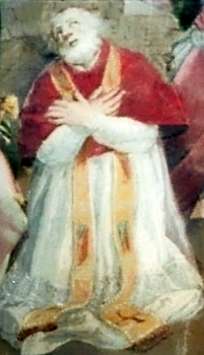Pope Anicetus
Pope Anicetus was the bishop of Rome from c. 157 to his death in April 168.[3] According to the Annuario Pontificio, the start of his papacy may have been 153. Anicetus actively opposed Gnosticism and Marcionism. He welcomed Polycarp of Smyrna to Rome, to discuss the controversy over the date for the celebration of Easter.
Pope Saint Anicetus | |
|---|---|
| Bishop of Rome | |
 | |
| See | Holy See |
| Papacy began | c. 157 |
| Papacy ended | c. 20 April 168 |
| Predecessor | Pius I |
| Successor | Soter |
| Personal details | |
| Born | late 1st century Emesa, Phoenice |
| Died | April 168 Rome, Roman Empire |
| Sainthood | |
| Feast day | 20 April[1] (West) 17 April[2] (East) |
| Attributes | Papal tiara, palm branch |
Biography
According to the Liber Pontificalis, Anicetus was a Syrian from the city of Emesa (modern-day Homs).[4]
According to Irenaeus, it was during his pontificate that the aged Polycarp of Smyrna, a disciple of John the Evangelist, visited Rome to discuss the celebration of Passover with Anicetus. Polycarp and his Church of Smyrna celebrated the crucifixion on the fourteenth day of Nisan, which coincides with Pesach (or Passover) regardless of which day of the week upon this date fell, while the Roman Church celebrated the Pasch on Sunday—the weekday of Jesus's resurrection. The two did not agree on a common date, but Anicetus conceded to Polycarp and the Church of Smyrna the ability to retain the date to which they were accustomed. The controversy was to grow heated in the following centuries.[5]
The Christian historian Hegesippus also visited Rome during Anicetus's pontificate. This visit is often cited as a sign of the early importance of the Roman See.[5]
Anicetus actively opposed the Gnostics and Marcionism.[6] The Liber Pontificalis records that Anicetus decreed that priests are not allowed to have long hair (perhaps because the Gnostics wore long hair).[4]
According to church tradition, Anicetus suffered martyrdom during the reign of Emperor Lucius Verus, but there are no historical grounds for this account.[7] 16, 17 and 20 April are all cited as the date of his death, but 20 April is currently celebrated as his feast day.[1] Before 1970, the date chosen was 17 April.[7] The Liber Pontificalis states he was buried in the cemetery of Callistus.[4]
See also
References
- Martyrologium Romanum (Libreria Editrice Vaticana 2001 ISBN 88-209-7210-7)
- (in Greek) Άγιος Ανίκητος ο Ιερομάρτυρας πάπας Ρώμης Ορθόδοξος Συναξαριστής
- Campbell, Thomas (1907). "Pope St. Anicetus" in The Catholic Encyclopedia. Vol. 1. New York: Robert Appleton Company.
- Raymond Davis (January 1, 2001). Book of the Pontiffs (Liber Pontificalis) (Liverpool University Press - Translated Texts for Historians). Liverpool University Press. p. 5. ISBN 9780853235453. OL 8283722M.
- Irenaeus, cited in Eusebius, Historia Ecclesiastica, 5.24; translated by G.A. Williamson, Eusebius: History of the Church (Harmondsworth: Penguin, 1965), pp. 232f
- Monks of Ramsgate. “Anicetus”. Book of Saints, 1921. CatholicSaints.Info. 20 July 2012

- Calendarium Romanum (Libreria Editrice Vaticana 1969), p. 120
External links
| Wikimedia Commons has media related to Pope Anicetus. |
- Campbell, Thomas Joseph (1907). . In Herbermann, Charles (ed.). Catholic Encyclopedia. 1. New York: Robert Appleton Company.
- Duff, Eamon. Saints and Sinners: A History of the Popes, Yale University Press, 2001, p. 13. ISBN 0-300-09165-6
- Maxwell-Stuart, P. G. Chronicle of the Popes: The Reign-by-Reign Record of the Papacy from St. Peter to the Present, Thames & Hudson, 2002, p. 19. ISBN 0-500-01798-0.
- "Anicetus" in the Ecumenical Lexicon of Saints
- Collected works of Migne Patrologia Latina
| Titles of the Great Christian Church | ||
|---|---|---|
| Preceded by Pius I |
Bishop of Rome 154–167 |
Succeeded by Soter |